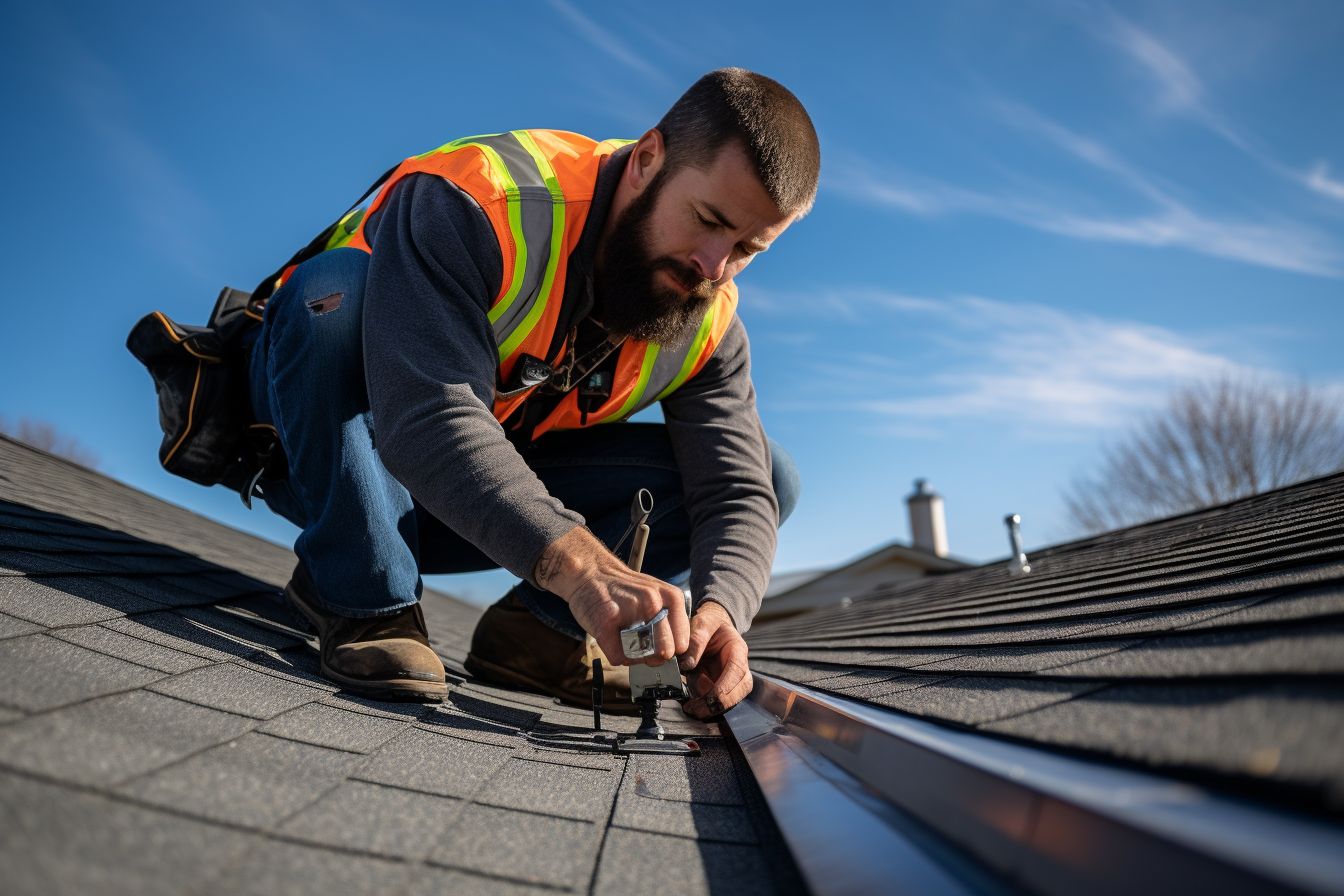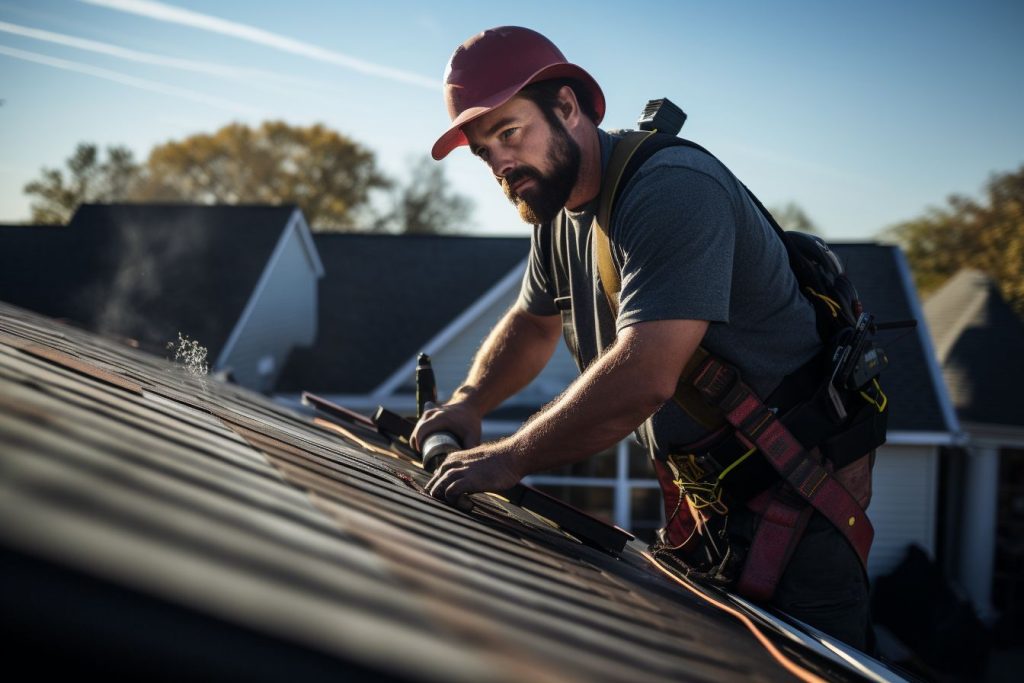Dealing with a leaking roof is a headache many homeowners face, often leading to significant expenses and damages. Did you know that simple maintenance practices can prevent most roofing leaks? In this blog post, we will walk through practical steps and tips on preventing future roof leaks helping keep your home safer, drier, and more comfortable.
Ready for a leak-free life? Let’s get started!
Key Takeaways
- Regular roof inspections can help identify leaks, drainage issues, and roof defects before they become significant problems.
- Addressing potential leak points such as flashing, drip edge, and gutter maintenance is crucial in preventing future roof leaks.
- Proper tree and branch maintenance can prevent damage to the roof from fallen trees and branches.
- Knowing how to handle roof leaks by promptly identifying the source, temporarily patching it, and promptly addressing water damage is essential for preventing further damage.
Regular Roof Inspections

Regular roof inspections can prove instrumental in maintaining the overall health of your roof. These inspections serve multiple purposes:
- Identifying leaks: Inspectors look for signs of water damage, peeling paint, or warped shingles that indicate a leak.
- Detecting drainage issues: They ensure that water channels and downspouts are clear of debris to allow proper runoff.
- Spotting roof defects: Inspections help discover missing or damaged shingles, cracks in the flashing, and other structural flaws.
- Planning preventative maintenance: Based on their findings, inspectors suggest timely repairs or replacements to avoid significant future damage.
- Scheduling crucial inspections: Experts recommend inspecting your roof twice a year – during spring to check winter damage and in autumn to prepare for harsh winter conditions.
Addressing Potential Leak Point

Inspect and repair flashing, maintain the drip edge, and adequately care for gutters to prevent potential roof leaks.
Flashing inspections and repairs
Fixing and maintaining roof flashings are vital in preventing potential roof leaks. Here’s how it works:
- Schedule flashing inspections at least twice annually to ensure your roof stays leak-proof.
- DIY repairs can be a feasible option for minor issues, allowing homeowners to fix leaks without professional experience.
- Familiarize yourself with the most common types of roof leaks – understanding these will help you pinpoint problems in your roof flashing.
- Investigate the problem thoroughly once detected; this helps you plan the correct action for repairing potential leaks.
- Manage detected leaks effectively until you can arrange for professional assistance; this can significantly reduce interior damage caused by leaks.
- Prioritize regular inspections and preemptive maintenance to lessen the chances of encountering future financial complications from neglected roof issues.
Checking and maintaining the drip edge
Proper care of the drip edge is vital in preventing future roof leaks.
- Examine the current status of your drip edge.
- Look for signs of damage or wear, such as cracks or rust.
- Check to ensure that the drip edge directs water into your gutters, not onto your roof and fascia.
- Make sure the installation is correct, with corners carefully cut to fit.
- Carry out repairs immediately if you notice any problems to prevent potential leaks.
- Regular maintenance helps the drip edge prevent water ingress into your property.
Proper gutter maintenance
Proper gutter maintenance is essential for preventing future roof leaks. To ensure your gutters are in prime condition, follow these essential steps:
- Regular cleaning: Remove leaves, twigs, or debris from the gutters to prevent blockages and clogs.
- Debris removal: Dispose of the collected debris properly to avoid accumulating in the gutters.
- Gutter repair: Inspect the gutters for cracks, holes, or loose fittings. Please repair or replace damaged sections as soon as possible.
- Gutter clog prevention: Install gutter guards to prevent leaves and other particles from entering and blocking the gutters.
- Winter gutter maintenance: Before winter arrives, clear out any remaining debris and ensure downspouts are clear of obstructions.
- Ice dam prevention: Keep gutters free of ice by using heat cables or removing snow accumulation.
- Regular inspection: Please check the gutters for sagging or improper drainage signs and address any issues immediately.
Tree and Branch Maintenance

Pruning low-hanging branches is critical to safeguarding the outer layer of the roof. Trimming back branches or removing problematic trees can extend the lifespan of gutters and prevent roof leaks. Fallen trees and broken branches have the potential to cause damage to structures, roofs, siding, windows, and cars, as well as topple power lines. Branches can scratch and damage shingles, accumulating moisture and potential leaks. Professional tree trimming and maintenance are highly recommended for preventing roof damage caused by trees.
Homeowner’s Manual: Handling Roof Leaks

Roof leaks can be a frustrating and damaging issue for homeowners. However, knowing how to handle them can help prevent further damage and save you money on repairs. The first step is to identify the source of the leak.
This can often be challenging as water may travel along rafters or beams before dripping onto your ceiling. Please look over your roof for missing or damaged shingles, as these are common areas where leaks happen.
Once you have identified the source, you can temporarily patch it with roofing cement or tape until a professional can repair it.
Next, I would like to point out that addressing any water damage caused by the leak is essential. Water stains on walls or ceilings should be treated promptly to prevent mould and mildew growth. Use a mixture of bleach and water to clean affected areas thoroughly.
To avoid future leaks, consider investing in regular roof inspections by professionals who check for potential issues that could lead to leaks. Also, please watch for signs of moisture accumulation, such as damp spots on your ceiling or peeling paint.
By following these steps and taking proactive measures, such as keeping gutters clean and maintaining adequate ventilation in your attic, you can minimise the risk of roof leaks and ensure your home stays dry and protected from costly water damage.
Conclusion
Preventing future roof leaks is crucial for your roof’s longevity and your home’s protection. Regular roof inspections, addressing potential leak points like flashing and drip edge maintenance, tree and branch upkeep, and following proper homeowner’s manual guidelines are essential to avoid water damage.
By taking these proactive measures, you can ensure a watertight roof that will withstand any rainstorm.
FAQs
1. How often should I inspect my roof to prevent future leaks?
Inspecting your roof at least twice a year, ideally in the spring and fall, is recommended to catch any potential issues before they become significant problems.
2. Can I prevent future roof leaks by cleaning my gutters regularly?
Yes, cleaning your gutters regularly is essential in preventing future roof leaks. Clogged gutters can cause water to back onto the roof and seep into the structure.
3. Are there any signs that indicate a need for immediate attention to prevent future roof leaks?
Yes, signs such as cracked or missing shingles, sagging areas on the roof, or stains on the ceilings inside your home indicate potential issues that require immediate attention to prevent future leaks.
4. What other measures can I take to prevent future roof leaks?
In addition to regular inspections and gutter maintenance, keeping trees trimmed away from your roof, ensuring proper attic ventilation, and addressing any flashing or chimney issues promptly can help prevent future roof leaks.
5. Is it necessary to hire a professional for preventative maintenance of my roof?
While homeowners themselves can do some proactive measures like gutter cleaning, hiring a professional roofing contractor is generally recommended for comprehensive preventative maintenance of your roof. They have specialised knowledge and equipment to identify potential issues early on and offer appropriate solutions.

